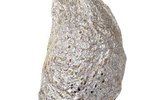
You have probably noticed tiny holes all over the edges of leaves on trees and plants in your yard -- not the serrated edges of some leaves but irregular missing bits. These holes were likely created by hungry caterpillars. Although caterpillars do not have actual teeth like those found in animals like cats and dogs, they do have mouthparts they use for chewing.
Caterpillar Chompers
An upper and lower lip surround a caterpillar's mandibles, or chewing appendages. The have two mandibles, which they use like a pair of shears to cut away at leaves. Caterpillars' mandibles are sideways, unlike teeth such as our own that open up and down. The caterpillar's setup makes biting through the surface of leaves impossible, so they munch on the sides of leaves. Caterpillars also have little sensory bumps under their mandibles called maxillary palps, which help them determine whether a plant is safe to eat. If it is, the maxillary palps help guide the food into the caterpillar's mouth.
On the Menu
Caterpillars are picky eaters. Monarch butterfly caterpillars solely feed on milkweeds, for instance. A female butterfly lays her eggs accordingly, choosing plants she knows her larvae will feed on after hatching. Directly after hatching from their eggs, the caterpillars first meals are their own egg shells, which they chew with their mandibles. Caterpillars begin to feed on plant foliage in preparation for becoming adult butterflies. It's rare, but some caterpillars, such as harvester butterfly larvae, are carnivores, feeding on little plant lice known as aphids.
Growing Up
Caterpillars eat so much plant foliage that they must shed their skin several times to make room for their growing bodies. Once caterpillars are full-grown, they stop feeding and prepare to become adults. To do so, the caterpillars spin cocoons, at which point they become pupae. While in their cocoons, the pupae do not feed. Instead, they use stored energy to develop adult butterfly parts like wings and antennae. Also during this transformation, the pupae develop new mouthparts.
Sipping Through Straws
Unlike caterpillars, butterflies do not chew on plant foliage for energy. Instead, they drink from strawlike mouthparts known as probosces, which they curl up when not in use. These tubes enable the butterflies to draw up nectar from flowers. The nectar provides butterflies with energy to fly, mate and lay eggs.
References
- Monarch Watch: Biology
- University of Minnesota: Larva and Caterpillar
- Northern Territory Government: Mouthparts of Insects and Mites
- University of Kentucky: All About Butterflies
- The Amateur Entomologists' Society: Insect Mouthparts
- ButterflyWorkx: Butterfly and Moth Questions
- University of Wisconsin-Milwaukee: Viceroy Butterfly (Family Nymphalidae)
- The Academy of Natural Sciences of Drexel University: Butterfly Life Cycle
- Butterfly Conservatory: Butterflies
- Journal of Comparitive Physiology: Maxillary Palps Can Mediate Taste Rejection of Plant Allelochemicals by Caterpillars
Photo Credits
-
Jupiterimages/Photos.com/Getty Images
Writer Bio
Amanda Williams has been writing since 2009 on various writing websites and blogging since 2003. She enjoys writing about health, medicine, education and home and garden topics. Williams earned a Bachelor of Science in biology at East Stroudsburg University in May 2013. Williams is also a certified emergency medical technician.



